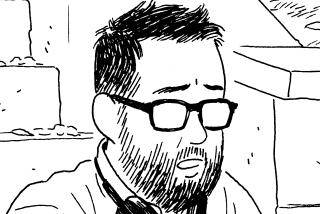A Second Look: Revisiting Terry Zwigoff’s early documentaries
A habitual crank with a pronounced antisocial streak and an aversion to mainstream culture, the director Terry Zwigoff has one of the most distinctive sensibilities in American movies. This past decade, he has collaborated with the cartoonist Daniel Clowes on “Ghost World” (2001), a sardonic chronicle of teenage alienation in strip-mall America, and “Art School Confidential” (2006), a contemptuous attack on art-world strivers, and also directed Billy Bob Thornton in the cult favorite “Bad Santa” (2003), a relentless one-joke movie about an alcoholic, misanthropic Saint Nick.
The themes that obsess Zwigoff in his fiction films — the experience of outsiderhood, the value of authenticity, the fraught intersection of art and commerce, not to mention of art and life — can be traced to his previous career as a documentary filmmaker. Two of his early works, both portraits of artists, are being reissued this week by the Criterion Collection on separate discs.
Zwigoff’s first film, “Louie Bluie” (1985) — about Howard Armstrong, an African American string-band leader and artist — establishes the director’s taste for esoterica and his antiquarian bent. (A collector of old-time jazz and blues records, Zwigoff has declared in interviews that he believes American popular culture peaked in the 1920s.) The loose-limbed “Louie Bluie” is Zwigoff’s most affectionate film, filled with infectious music and winning anecdotes from its subject, a world-class raconteur.
“Crumb” (1994), an up-close look at the underground comic artist Robert Crumb, remains Zwigoff’s most disturbing movie and signature film. (It is being released in both standard-definition and Blu-ray editions.) Zwigoff spent much of the nine-year period between the two films immersed in Crumb’s world. He and Crumb are old friends and fellow music buffs — they played together in Crumb’s ragtime band, the Cheap Suit Serenaders — and Zwigoff’s relatively unfettered access is crucial to the film’s success.
As Crumb and his wife, the cartoonist Aline Kominsky-Crumb, prepare to leave the States for the south of France (where they live to this day), Zwigoff accompanies the artist on a tour of ex-flames and old stamping grounds, notably San Francisco, where he settled in the ‘60s and was “liberated by LSD,” as he puts it. But the most memorable visits are with his brothers. Charles, a major artistic influence on the young Robert, has grown into a tormented recluse who lives at home with their mother; he killed himself before the film was completed. Max, an ascetic and occasional artist, is shown sitting on a bed of nails.
Crumb’s biography would seem to lend itself to biopic-style psychoanalysis. He and his brothers are products of a traumatic childhood: a tyrannical father, a mother who was addicted to amphetamines, high school bullying. But Zwigoff, digging into his subject’s contradictions and allowing them to remain unresolved, achieves a harrowing intimacy and complexity, both of which would likely have eluded a fiction filmmaker or a more squeamish documentarian.
It’s clear that for Crumb, art is both salvation and revenge. Zwigoff tackles head-on the central challenges in making a film about an artist — how to portray the work and the creative process and how to measure the distance between the art and the life. Experts attest to the importance of Crumb’s work (critic Robert Hughes invokes Breugel and Goya) and also wrestle with its problematic aspects (feminist critics point to the headless female torsos and identify a “juvenile vision”). The camera lingers on scenes of Crumb at work and on the work itself, panning from one panel to the next, while Crumb himself emphasizes (no surprise) the psychosexual point of view, admitting that his comics are masturbatory fantasies.
After the release of “Crumb,” and the elevated profile that came with it, Crumb’s art has grown less overtly personal — his recent work includes a version of the Book of Genesis. But the artist has remained a shadow presence in Zwigoff’s fiction films. The Steve Buscemi character in “Ghost World,” a record-collecting malcontent, is very much an R. Crumb figure; Crumb’s then-teenage daughter Sophie contributed the drawings made by the film’s heroine. And in “Art School Confidential,” Jim Broadbent, in a performance that unavoidably carries the specter of Charles Crumb, dominates his every scene as an embittered, washed-up painter who becomes the young hero’s anti-mentor, a true artist simultaneously destroyed and enlightened by his worldly failure.
More to Read
Only good movies
Get the Indie Focus newsletter, Mark Olsen's weekly guide to the world of cinema.
You may occasionally receive promotional content from the Los Angeles Times.










